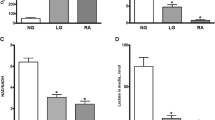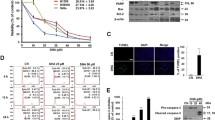Abstract
Marine n−3 FA are known to inhibit proliferation or induce cell death in several cancer cell lines. We have previously reported that EPA promotes apoptosis in the lymphoma cell line Ramos, whereas the U-698 cell line is insensitive to EPA. Furthermore, acyl-CoA synthetase (ACS) is expressed to a higher extent in Ramos cells compared to U-698 cells. To investigate the importance of ACS in EPA-induced apoptosis, we incubated Ramos cells with triacsin C, an inhibitor of ACS. This caused a 70% reduction in the amount of cell-associated EPA and diminished activation of EPA. In addition, triacsin C caused a 90% reduction in EPA-induced apoptosis. Several different approaches were tried to overexpress ACS4 in EPA-insensitive lymphoma cell lines, but we did not obtain viable cells with high expression of acyl-CoA activation. However, we show that overexpression of ACS4 in the more robust COS-1 cells caused up to a fivefold increase in activation of EPA and a 67% increase in the amount of cell-associated radiolabeled EPA. Furthermore, we observed 28% elevated cellular level of TAG in EPA-incubated COS-1 cells overexpressing ACS4. The present study provides new information about ACS as an important enzyme for EPA-induced apoptosis in Ramos cells. Our data offer a potential mechanism that may explain the effect of dietary marine n−3 PUFA on growth of certain malignant cells.
Similar content being viewed by others
Abbreviations
- AA:
-
arachidonic acid
- ACS:
-
acyl-CoA synthetase
- FABP:
-
fatty acid-binding protein
- HO342:
-
Hoechst 33342
- OA:
-
oleic acid
References
Ingram, D.M., Nottage, E., and Roberts, T. (1991) The Role of Diet in the Development of Breast Cancer: A Case-Control Study of Patients with Breast Cancer, Benign Epithelial Hyperplasia and Fibrocystic Disease of the Breast, Br. J. Cancer 64, 187–191.
Kaizer, L., Boyd, N.F., Kriukov, V., and Tritchler, D. (1989) Fish Consumption and Breast Cancer Risk: An Ecological Study, Nutr. Cancer 12, 61–68.
Landa, M.C., Frago, N., and Tres, A. (1994) Diet and the Risk of Breast Cancer in Spain, Eur. J. Cancer Prev. 3, 313–320.
Albino, A.P., Juan, G., Traganos, F., Reinhart, L., Connolly, J., Rose, D.P., and Darzynkiewicz, Z. (2000) Cell Cycle Arrest and Apoptosis of Melanoma Cells by Docosahexaenoic Acid: Association with Decreased pRb Phosphorylation, Cancer Res. 60, 4139–4145.
Begin, M.E., Ells, G., Das, U.N., and Horrobin, D.F. (1986) Differential Killing of Human Carcinoma Cells Supplemented with n−3 and n−6 Polyunsaturated Fatty Acids, J. Natl. Cancer Inst. 77, 1053–1062.
Begin, M.E., and Ells, G. (1987) Effects of C18 Fatty Acids on Breast Carcinoma Cells in Culture, Anticancer Res. 7, 215–217.
Begin, M.E., Ells, G., and Horrobin, D.F. (1988) Polyunsaturated Fatty Acid-Induced Cytotoxicity Against Tumor Cells and Its Relationship to Lipid Peroxidation, J. Natl. Cancer Inst. 80, 188–194.
Rose, D.P., and Connolly, J.M. (1990) Effects of Fatty Acids and Inhibitors of Eicosanoid Synthesis on the Growth of a Human Breast Cancer Cell Line, in Culture, Cancer Res. 50, 7139–7144.
Finstad, H.S., Myhrstad, M.C., Heimli, H., Lomo, J., Blomhoff, H.K., Kolset, S.O., and Drevon, C.A. (1998) Multiplication and Death-Type of Leukemia Cell Lines Exposed to Very Long-Chain Polyunsaturated Fatty Acids, Leukemia 12, 921–929.
Heimli, H., Finstad, H.S., and Drevon, C.A. (2001) Necrosis and Apoptosis in Lymphoma Cell Lines Exposed to Eicosapentaenoic Acid and Antioxidants, Lipids 36, 613–621.
Finstad, H.S., Dyrendal, H., Myhrstad, M.C., Heimli, H., and Drevon, C.A. (2000) Uptake and Activation of Eicosapentaenoic Acid Are Related to Accumulation of Triacylglycerol in Ramos Cells Dying from Apoptosis, J. Lipid Res. 41, 554–563.
Black, P.N., DiRusso, C.C., Metzger, A.K., and Heimert, T.L. (1992) Cloning, Sequencing, and Expression of the fadD Gene of Escherichia coli Encoding Acyl Coenzyme A Synthetase, J. Biol. Chem. 267, 25513–25520.
Fujino, T., and Yamamoto, T. (1992) Cloning and Funtional Expression of a Novel Long-Chain Acyl-CoA Synthetase Expressed in Brain, J. Biochem. (Tokyo) 111, 197–203.
Kang, M.J., Fujino, T., Sasano, H., Minekura, H., Yabuki, N., Nagura, H., Iijima, H., and Yamamoto, T.T. (1997) A Novel Arachidonate-Preferring Acyl-CoA Synthetase Is Present in Steroidogenic Cells of the Rat Adrenal, Ovary, and Testis, Proc. Natl. Acad. Sci. USA 94, 2880–2884.
Suzuki, H., Kawarabayasi, Y., Kondo, J., Abe, T., Nishikawa, K., Kimura, S., Hashimoto, T., and Yamamoto, T. (1990) Structure and Regulation of Rat Long-Chain Acyl-CoA Synthetase, J. Biol. Chem. 265, 8681–8685.
Heimli, H., Giske, C., Naderi, S., Drevon, C.A., and Hollung, K. (2002) Eicosapentaenoic Acid Promotes Apotosis in Ramos Cells via Activation of Caspase-3 and −9, Lipids 37, 797–802.
Natarajan, V., Holven, K.B., Reppe, S., Blomhoff, R., and Moskaug, J.O. (1996) The C-Terminal RNLL Sequence of the Plasma Retinol-Binding Protein Is Not Responsible for Its Intracellular Retention, Biochem. Biophys. Res. Commun. 221, 374–379.
Lewin, T.M., Kim, J.H., Granger, D.A., Vance, J.E., and Coleman, R.A. (2001) Acyl-CoA Synthetase Isoforms 1,4, and 5 Are Present in Different Subcellular Membranes in Rat Liver and Can Be Inhibited Independently, J. Biol. Chem. 276, 24674–24679.
Tomoda, H., Igarashi, K., and Omura, S. (1987) Inhibition of Acyl-CoA Synthetase by Triacsins, Biochim. Biophys. Acta 921, 595–598.
Braden, L.M., and Carroll, K.K. (1986) Dietary Polyunsaturated Fat in Relation to Mammary Carcinogenesis in Rats, Lipids 21, 285–288.
Chang, W.C., Chapkin, R.S., and Lupton, J.R. (1997) Predictive Value of Proliferation, Differentiation and Apoptosis as Intermediate Markers for Colon Tumorigenesis, Carcinogenesis 18, 721–730.
Jurkowski, J.J., and Cave, W.T., Jr. (1985) Dietary Effects of Menhaden Oil on the Growth and Membrane Lipid Composition of Rat Mammary Tumors, J. Natl. Cancer Inst. 74, 1145–1150.
Noding, R., Schonberg, S.A., Krokan, H.E., and Bjerve, K.S. (1998) Effects of Polyunsaturated Fatty Acids and Their n−6 Hydroperoxides on Growth of Five Malignant Cell Lines and the Significance of Culture Media, Lipids 33, 285–293.
Sagar, P.S., Das, U.N., Koratkar, R., Ramesh, G., Padma, M., and Kumar, G.S. (1992) Cytotoxic Action of cis-Unsaturated Fatty Acids on Human Cervical Carcinoma (HeLa) Cells: Relationship to Free Radicals and Lipid Peroxidation and Its Modulation by Calmodulin Antagonists, Cancer Lett. 63, 189–198.
Kim, J.H., Lewin, T.M., and Coleman, R.A. (2001) Expression and Characterization of Recombinant Rat Acyl-CoA Synthetases 1, 4, and 5. Selective Inhibition by Triacsin C and Thiazolidinediones, J. Biol. Chem. 276, 24667–24673.
Rusinol, A.E., Cui, Z., Chen, M.H., and Vance, J.E. (1994) A Unique Mitochondria-Associated Membrane Fraction from Rat Liver Has a High Capacity for Lipid Synthesis and Contains Pre-Golgi Secretory Proteins Including Nascent Lipoproteins, J. Biol. Chem. 269, 27494–27502.
Author information
Authors and Affiliations
Corresponding author
About this article
Cite this article
Heimli, H., Hollung, K. & Drevon, C.A. Eicosapentaenoic acid-induced apoptosis depends on acyl CoA-synthetase. Lipids 38, 263–268 (2003). https://doi.org/10.1007/s11745-003-1059-z
Received:
Revised:
Accepted:
Issue Date:
DOI: https://doi.org/10.1007/s11745-003-1059-z




